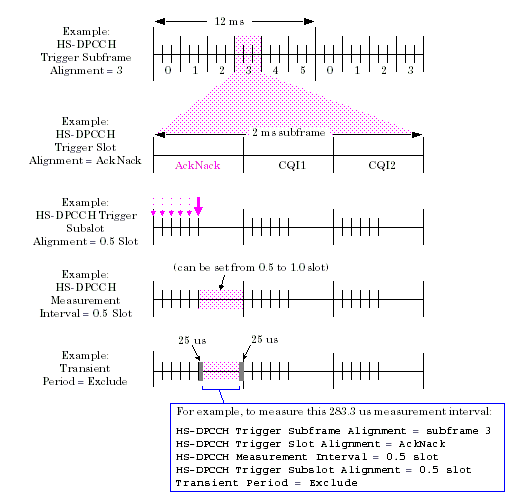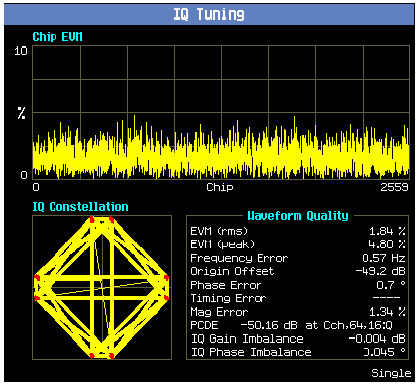IQ Tuning Measurement Description
Last updated: January 16, 2009
-
How is an IQ Tuning Measurement Made?
- Measurement Interval in Non-HSDPA Mode
- Measurement Interval in HSDPA Mode ( lab application or feature-licensed test application only )
-
IQ Tuning Measurement Parameters
- HSDPA Measurement Parameters ( lab application or feature-licensed test application only )
- IQ Tuning Measurement Results
- IQ Tuning Input Signal Requirements
- IQ Tuning Measurement Calibration
How is an IQ Tuning Measurement Made?
The IQ tuning measurement includes all of the measurements available in the Waveform Quality measurement (see Waveform Quality Measurement Results ), along with the following measurement results:
-
Chip EVM
Chip EVM is the calculated EVM at each chip in the measured timeslot. Chip EVM is measured as a 2560 element array of 32-bit floating point numbers. The first element in the array corresponds to the measured EVM for the first chip in the measured time slot, the second element to the EVM for the second chip in the measured time slot, and so on. These results are available graphically on the front panel display and numerically via the GPIB commands.
-
IQ constellation diagram
The IQ constellation is the measured IQ signal with origin offset included. IQ constellation is measured as a 2560 element array of ordered pairs. Each ordered pair consists of two 32-bit floating point numbers corresponding to one point in the IQ constellation. The first member in the ordered pair is the I coordinate, the second is the Q coordinate. The array is scaled so all points fall within a unit circle. The first ordered pair in the IQ constellation array corresponds to the first chip in the measured time slot, the second ordered pair in the array corresponds to the second chip in the measured time slot, and so on. The IQ constellation result is only available graphically on the front panel display. It is not be accessible via the GPIB commands.
Measurement Interval in Non-HSDPA Mode
When on a non-HSDPA connection, you must set
Trigger Source
to any value other than
HS-DPCCH
. When operating in this mode, the measurement is made during one timeslot (666.7 us). You can choose in which timeslot of the W-CDMA frame the measurement is performed using the
Timeslot
setting.
Measurement Interval in HSDPA Mode
This section is only applicable to the lab application or feature-licensed test application .
To measure IQ tuning on an HSDPA connection, you must set
Trigger Source
to
HS-DPCCH
. When
Trigger Source
is set to HS-DPCCH, you can specify the measurement interval and its placement within any of the 6 HSDPA subframes.
- Use the HS-DPCCH Trigger Subframe Alignment setting to choose in which 2 ms subframe (0 to 5) you want to place the measurement interval.
-
Use the
HS-DPCCH Trigger Slot Alignment
setting to specify in which slot within the subframe you want to place the measurement interval (
AckNack= the first slot of the subframe,CQI1= the second slot of the subframe andCQI2= the third slot of the subframe). -
Set the duration of the measurement interval using the
HS-DPCCH Measurement Interval
setting. Note that the sum of
HS-DPCCH Trigger Subslot AlignmentandHS-DPCCH Measurement Intervalcannot exceed 1.0 slot. -
Use the
HS-DPCCH Trigger Subslot Alignment
setting to specify where you want to place the measurement interval within the slot. You can place the measurement interval at the slot boundary, 0.1 slot (66.7 us) after the slot boundary, 0.2 slot (133.3 us) after the slot boundary... up to 0.5 slot (333.3 us) after the slot boundary. Note, however, that the sum of
HS-DPCCH Trigger Subslot AlignmentandHS-DPCCH Measurement Intervalcannot exceed 1.0 slot. If you wish to place the measurement interval after the slot boundary using theHS-DPCCH Trigger Subslot Alignmentsetting, you must first decrease theHS-DPCCH Measurement Intervalsetting appropriately. -
You can choose to shorten the measurement interval so as to exclude the 25 us (96 chip) transient periods at the start and end of the measurement interval using the
Transient Period
setting. For example, if you set
HS-DPCCH Measurement Intervalto0.5 slot(333.3 us or 1280 chips) and setTransient PeriodtoExclude, the measurement is performed over 283.3 us (or 1088 chips).
IQ Tuning Measurement Parameters
-
Timeslot
When Trigger Source is set to any value other than
HS-DPCCH, you can specify which timeslot of the W-CDMA frame (0 to 14) is evaluated by the IQ tuning measurement. See Measurement Interval in Non-HSDPA Mode . - Trigger Arm: see Trigger Arm (Single or Continuous) Description .
-
Trigger Source
Triggering choices are immediate, protocol, external, auto and HS-DPCCH ( lab application or feature-licensed test application only ). See Trigger Source Description for more information.
Auto triggering is the default choice. In most cases, auto triggering provides the optimum measurement triggering condition for the IQ tuning measurement. For example, if the UE is synchronized to the test set, auto triggering causes protocol triggering to be used. Auto triggering causes immediate triggering is used if the UE is not synchronized. When immediate triggering is used, the measurement result returned for timing error is always
NAN(Not a Number) because it is not possible to evaluate a timing error in this measurement situation. - Measurement Timeout: see Measurement Timeouts .
HSDPA Measurement Parameters
This section is only applicable to the lab application or feature-licensed test application .
These settings are only applicable when
Trigger Source
=
HS-DPCCH
.
See Measurement Interval in HSDPA Mode for more information about using these parameters to specify the duration and placement of the measurement interval.
-
Transient Period
When
Transient Periodis set toInclude, the measurement is performed over the interval specified by the HS-DPCCH Measurement Interval setting.When
Transient Periodis set toExclude, the 25 us at the start of the measurement interval and the 25 us at the end of the measurement interval are excluded from the measurement. Thus, the measurement is performed over an interval equal to HS-DPCCH Measurement Interval minus 50 us. See Measurement Interval in HSDPA Mode . -
HS-DPCCH Trigger Subframe Alignment
Selects which 2 ms subframe (0 to 5) contains the measurement interval.
-
HS-DPCCH Trigger Slot Alignment
Selects which slot in the 2 ms subframe contains the measurement interval (
AckNack= the first slot in the subframe,CQI1= the second slot in the subframe andCQI2= the third slot in the subframe). -
HS-DPCCH Measurement Interval
See Measurement Interval in HSDPA Mode .
Note, the sum of HS-DPCCH Trigger Subslot Alignment and
HS-DPCCH Measurement Intervalcannot exceed 1.0 slot. -
HS-DPCCH Trigger Subslot Alignment
Selects where to place the measurement interval within the slot, in 0.1 slot (66.7 us) increments. This is useful because depending upon the Current DPCH Offset , the uplink DPCH and HS-DPCCH can be offset in time by increments of 0.1 slot (see HS-DPCCH/DPCCH Alignment vs. DPCH Frame Offset ).
Note, the sum of
HS-DPCCH Trigger Subslot Alignmentand HS-DPCCH Measurement Interval cannot exceed 1.0 slot.
IQ Tuning Measurement Results
Chip EVM and the IQ constellation are graphed together on the same screen. See figure
IQ Tuning Graph Display
for an example display. You can use the
Axis Control
(
F2
) and the
Marker
(
F3
) settings to control the Chip EVM trace graph and the IQ constellation diagram. The IQ constellation diagram is always redrawn to reflect the latest Chip EVM settings. For example, if the chip EVM for chips 512 through 1023 are plotted, then the IQ constellation is shown for just chips 512 through 1023. The I and Q values for the IQ constellation all range between -1.0 and +1.0.
The IQ tuning measurement also returns all of the measurement results of the Waveform Quality measurement. Waveform Quality Measurement Results
IQ Tuning Input Signal Requirements
- For this measurement the test set's receiver uses auto-ranging to adjust for the level of the signal being measured; therefore the expected signal level does not need to be specified during measurement setup. However, it is recommended that Expected Power be configured to match the actual signal level expected to ensure the auto-ranging procedure executes as quickly as possible.
- The frequency of the signal being measured must be in the range of 800 MHz to 1000 MHz, 1700 MHz to 1990 MHz, or 2480 MHz to 2580 MHz.
- The level into the test set's RF IN/OUT connector must be in the range of -25 dBm to +28 dBm, in a 3.84 MHz bandwidth.
- Maximum measurable EVM = 35%
- Maximum measurable timing error = +/- 50 chips
IQ Tuning Measurement Calibration
This measurement should be calibrated using the Calibrate Measurements function ( CALibration:MEASurements? ) when the temperature has changed by ± 10° C or more since the last calibration. If this situation exists, the integrity indicator value becomes 19 and a message is displayed indicating "Uncalibrated Due to Temperature".


